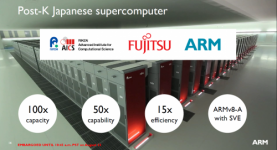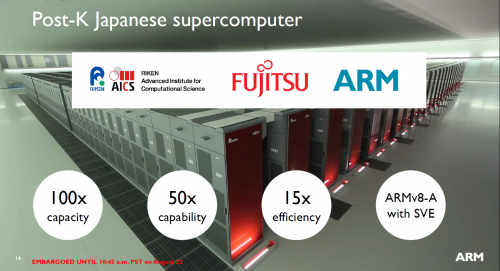
After killing Samsung CPU, Arm’s odds of entering the data center are geometric
On December 10, Apple officially said that its latest processor, the A13, contains a total of 8.5 billion transistors. In 1995, Pixar’s first animated film “Toy Story” was released, with a total of 117 servers behind it for data support, and the corresponding number of transistors was 1 billion. A simple calculation shows that the data processing capability of the iPhone 11 series mobile phones equipped with A13 can cover the calculation of 8.5 animated feature films 24 years ago.
The coin is unbreakable on both sides
Opportunities are often behind pressure, because there is no breaking or standing. The best example is that the explosive growth of data volume has also directly spawned a huge market covering the entire industry chain, including semiconductor architecture providers, cloud computing service providers, and traditional semiconductor design manufacturers. IDC data shows that by 2023, the data center market will reach 300 billion US dollars, and the total amount of data will increase to 175ZB in 2025.

Image source | Arm official website
In the field of data center processors, Intel occupies the top spot with a market share of 90%, and the aggressive AMD, through the “64 core + 128 channel” configuration of the Xiaolong 7742 processor, far surpasses Intel in multiple running score competitions. Xeon Platinum 8280, the public opinion hegemony between the two sides has provided a steady stream of talks for the industry.
But it’s worth noting that AMD processors are based on the X86 architecture – an ecosystem dominated by Intel. On the other hand, in the field of server-level GPUs, Nvidia, which has a head-to-head confrontation with Intel; the mainstream cloud computing service providers headed by Amazon started the road of chip self-development; the code-named Astra abandoned the mainstream Intel platform and used the Marvell Thunder X computing platform. Build the supercomputing project Astra. The traceability is all from the support of the Arm architecture.
Last month, Samsung announced the dissolution of the CPU department in Austin, USA, announcing the failure of its fully self-developed CPU plan based on the Arm architecture. So far, in addition to Apple mobile phones, the built-in processors of mobile terminals on the market all use Arm architecture and solutions without exception. From the perspective of competition, it is not conducive to the burst of innovation and improvement. For the same reason, refer to the desktop side. Before AMD released the Zen series processors, the performance of Intel-related products did not improve by leaps and bounds within two years.
Killing opponents is absolutely dominant
The Samsung CPU R&D department was established in 2012, and has been given high hopes as a benchmark for the Arm architecture processor. The processor code-named M1 earlier was used in the Exynos 8890 SoC solution, and the latest M5 processor was used in the Exynos 990 solution. Although the main reason for its withdrawal from the market is that the research and development costs are too high and the sales profits cannot be supported.
However, the direct thrust of this event is that Arm successively launched Deimos (Cortex-A77) and Hercules (Cortex-A78) CPU cores, as well as processors based on the ARMv9 architecture, constantly raising the threshold for Samsung to catch up, eventually leading to its surrender, A direct re-use of the Arm CPU architecture.
They are also the architecture leaders in their respective fields. Unlike Intel’s initiative to slash the mobile baseband business, Arm has not stopped at the absolute advantage of the mobile terminal, and its ambitions in the server field have never been extinguished.
In 2017, Qualcomm launched a chip solution for the server market based on the Arm architecture, but it failed only a year later. Interestingly, the two sides have taken different paths so far.
Relative weakness never stops
Qualcomm releases Cloud AI 100 solution for data center AI inference budgets. Although the official has not disclosed the underlying architecture of the chipset, industry analysts say that it is an application-specific integrated circuit ASIC, which may adopt a model similar to Google’s Tensor Processing Unit (Tensor Processing Unit) to deal head-on with NVIDIA and Intel’s challenge.
At the same time, Arm cooperated with Amazon to open the platform code-named Cosmos to enable the construction of Graviton, a dedicated processor for Amazon’s cloud servers. It is reported that the first-generation server based on Graviton has a 30% price-performance advantage, and the corresponding increase of the second-generation server can reach 40%.
According to data from Synergy Research Group, as of Q1 2018, Amazon accounted for 33% of the global cloud hardware market, far ahead of Microsoft (13%) and Google (6%).
Nvidia founder and CEO Jen-Hsun Huang predicts that Arm has more than 100 billion computing devices so far, and that number will exceed 1 trillion in the next few years. Therefore, it has cooperated with technology companies such as Arm to launch GPU-accelerated Arm servers, which can meet diverse high-performance computing needs from the cloud to the edge through joint development with the alliance companies.
Also, in April, Arm invested in Ampere, a startup focused on server processors. The company, founded by former Intel president Renée James, launched the eMAG series of processors last October. Earlier, it purchased AppliedMicro’s X-Gene ARM-based server assets and provided custom 32-core chips based on the ARM v8.0 architecture.
Given that Arm does not have a tradition of investing in processor design companies, industry analysts believe that this plan will carry out more in-depth cooperation with Ampere in the processor market. Recently, Ampere released an ARM-based server chip platform, the eMAG workstation, which adopts a single-processor socket design and is installed in an XL-ATX chassis.
The platform comes with 32MB of L3 cache, 42 PCIe lanes, and 8 memory lanes. Supports up to 512GB of DDR4-2666 memory, NVMe solid state drives, SATA hard drives, and IPMI interfaces, including video output and PCIe 3.0 x8 expansion slots (additional drivers can be added).
Image source| Network
In terms of supercomputing, Sandia National Laboratory, a subsidiary of the US Department of Energy, announced the construction of supercomputing Astra, an ARM processor, with a floating-point performance of 2.3PFLOPS. Among them, the ThunderX2 processor based on the Arm architecture supports single-channel 32-core, dual-channel 64-core configuration, supports 4 threads per core, the standard frequency is 2.5GHz, and the acceleration frequency is 3GHz. Although the performance is far from the TOP500 head supercomputer, it is of great significance to the Arm camp.
write at the end
Regarding the current market share of X86 architecture processors in the data center and supercomputing field, the Arm camp cannot enter the central position in the short term, but under the trend of cloud computing and artificial intelligence, data processing with massive software applications may generate more Diversified needs. Users tend to configure a more cost-effective processor solution for a single data module.
Compared with data processing in the traditional sense, the GPU and engine of the Arm architecture are more advantageous in the scenarios of intelligent storage and software-defined networks under massive machine learning and inference tasks. But as mentioned above, multi-dimensional competition is the only antidote to promote the innovation of the entire industry.
Author: Pei Jun
The Links: FF600R12KF4 G150XTN066 LCD-COMPANY



